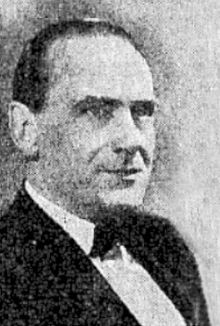| This article includes a list of references, related reading, or external links, but its sources remain unclear because it lacks inline citations. Please help improve this article by introducing more precise citations. (May 2014) (Learn how and when to remove this message) |

Lee Sims (April 30, 1898 - May 7, 1966) was an American pianist, composer, record maker, publisher and performer.
Early life
Lee Sims was born April 30, 1898, in Champaign, Illinois, under the full name Cleo Orville Sims. Cedar Rapids, Iowa, was his hometown while growing up. At the age of 8, he played ragtime and waltzes for a YMCA calisthenics class in Cedar Rapids. By age 11, he was accompanying church singers and playing the theatre pipe organ for silent movies. At 14, he played at the Majestic Theater in LaSalle, Illinois. While still in his teens, he went to work for a pipe organ manufacturer, demonstrating instruments all over the country.
Career
At age 22, Sims decided to settle down in Chicago. He began making piano rolls for the United States Piano Roll Company and other piano roll companies. Today, these rolls are sought after by collectors. He became studio manager for WTAS, one of the first radio stations in the Middle West. Later, he was studio manager of KYW, the Westinghouse station in Chicago, and WBBM, then the Stewart-Warner "theatre of the air".
As a radio performer, Sims had a late-night program called "Piano Moods" over the Chicago NBC affiliate station, WMAQ. He founded the Lee Sims School of Music, and one of his pupils was Ilomay Bailey, who had been a vocalist with the Paul Ash and Ben Pollack orchestras. Prior to singing with these orchestras, Ilomay had had formal vocal training. The two were married and formed a team. Sims introduced Ilomay Bailey on his "Piano Moods" radio program and created an instant sensation.
In the 1930s, Lee and Ilomay appeared as stars of the Chase and Sanborn Hour night program for the National Broadcasting Company. Other radio appearances included Rudy Vallee's program and the Ben Bernie and Phil Baker shows. In the 1937 movie "Dinner At The Ritz" (starring David Niven a.o.) Sims can be heard on piano with a band directed by Muir Mathieson although the band on screen is an unknown black outfit.
During the 1920s and 1930s, Sims recorded approximately 60 sides for Brunswick. He published several courses on modern piano and numerous arrangements (or "transcriptions") of popular tunes of the day. Many original sheet music editions included a bonus Lee Sims chorus for the more proficient and adventurous performers. After his heyday as a radio performer and recording artist, Sims devoted most of his time to teaching in his New York studio apartment, where Ilomay taught voice.
Influences
Lee Sims was deeply imbued with the nineteenth century European tradition and especially interested in the newer, impressionistic harmonies of Debussy and Ravel. While he recorded mostly sentimental popular songs, he had more serious ideas and aspirations. In 1928, his collection of "Five Piano Rhapsodies" was published. In that same year, Sims recorded two of the “Rhapsodies” arranged for piano and orchestra on a Brunswick 12" disk. Sims appeared with the London Symphony Orchestra to play his symphonic tone poem, "Blythewood," with an orchestration by Ferde Grofe. Art Tatum biographer James Lester described Sims's compositions as being "drawn from the same sources as Bix Beiderbecke's 'In a Mist'."
Sims's style, though somewhat outside of the realm of jazz, as it is typically considered today, was well within it in the era of his prominence. Nevertheless, Sims influenced the great jazz pianist Art Tatum, who used chord voicings and other devices that Sims employed, for example, the exploration of a song at its outset in a legato style, along with "Debussy-esque" chords, prior to launching into "bouncier" tempos and rhythms.
References
- "Leigh Kamman & Art Tatum interview". YouTube. Archived from the original on 2021-12-21. Retrieved January 11, 2020.
Sources
- Clarke, Donald, editor. "Zez Confrey," The Penguin Encyclopedia of Popular Music, 2nd ed., 1998.
- Kernfeld, Barry, editor. The New Grove Dictionary of Jazz, 1994.
- Lester, James. Too Marvelous for Words: The Life and Genius of Art Tatum, Oxford University Press, New York, 1994. 240 pages.
- New York Times, obituary, May 9, 1966.
- Rubine, Irving, Radio Guide, June 4–10, 1933, Chicago.
- The Moods of Love, long-play phonograph record liner notes, Radio Corporation of America, 1956.